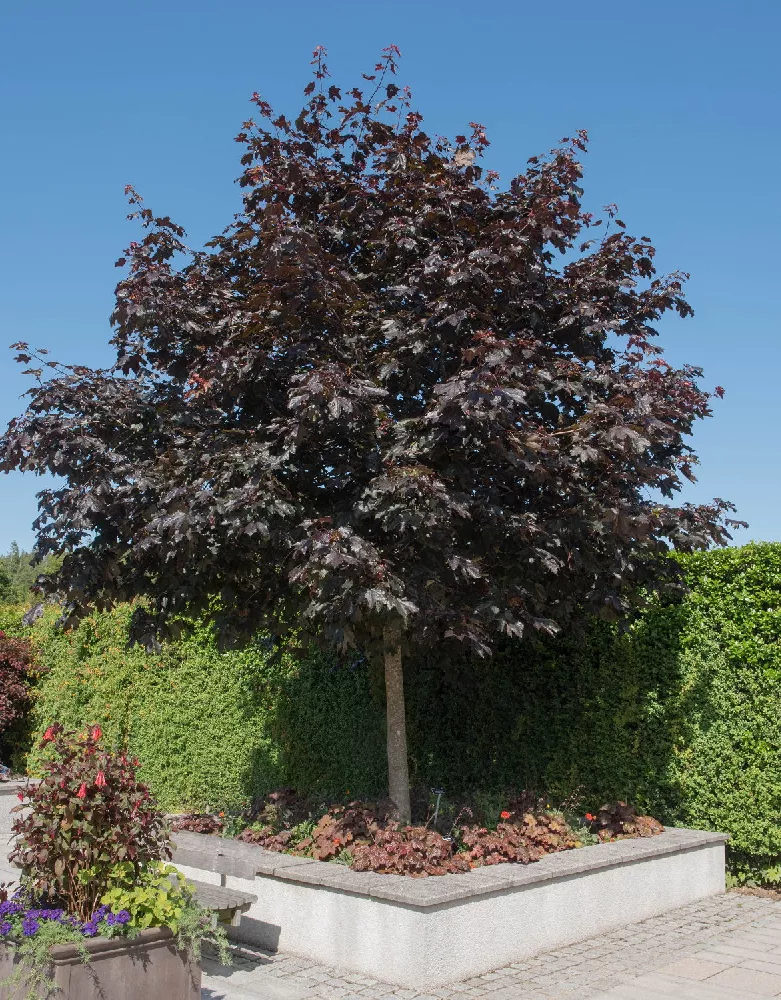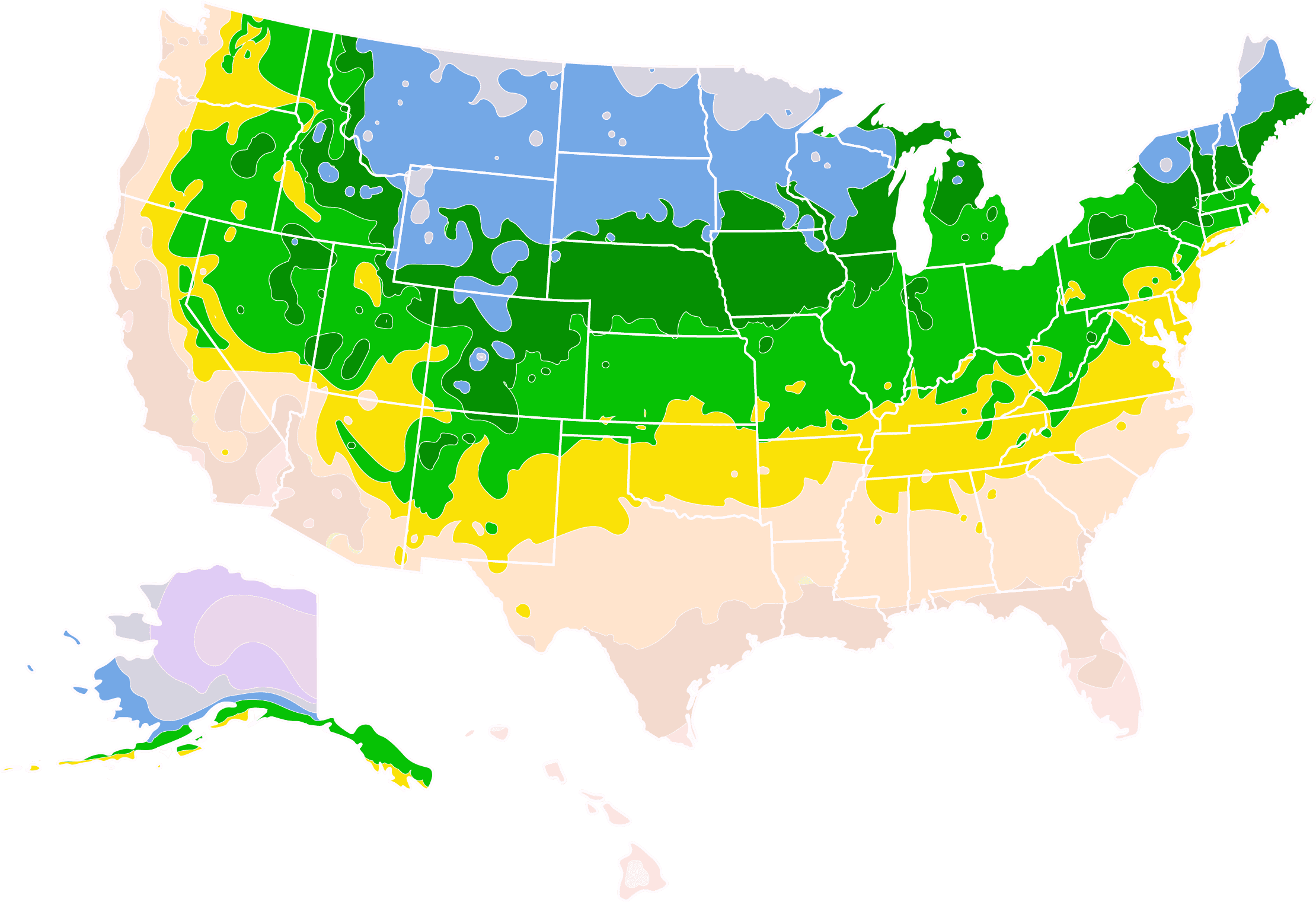- Home >
- Maple Trees >
- Crimson King Maple Tree
Crimson King Maple Tree for Sale - Buying & Growing Guide
The Crimson King maple tree is prized for its full shape and vibrant burgundy leaves. A type of Norway maple, Acer platanoides 'Crimson King' can grow to a height of up to 75 feet. It makes an excellent specimen tree or can be an eye-catching part of a small grove. Given adequate care when it's young, it is low-maintenance and needs little pruning. It thrives throughout much of the contiguous U.S. and is not bothered by temperatures as low as -25 degrees Fahrenheit. Here are some other reasons to plant Crimson King maple tree:
- Can handle soil that is either alkaline or acidic, with a pH range from 4 to 7.5.
- Resistant to air pollution, making it a good choice for urban yards or near roadways.
- Full, dense crown provides excellent shade.
Enter your zip code to find nearby stores that may carry this plant.
Plant Care
Sunlight

The Crimson King Maple tree does best in full sun to partial shade: aim for six hours or more of sun a day.
Watering
Water deeply when young, but avoid standing water. Mature trees are fairly drought-resistant.
Fertilizing

Fertilize in early spring with a slow-release general purpose fertilizer designed for landscape trees.
Planting and Care
Planting instructions
Unpot your maple sapling and tease apart the roots so that they are not encircling the root ball, which can gradually kill the tree. Dig a hole that’s slightly deeper than the root ball and twice as wide. Throw in some well-rotted organic manure or compost, and place the tree so that the top of the root ball is just under the soil level. Replace dirt around the roots, mixing it with compost or manure as you go. Tamp down soil to eliminate air pockets. Water thoroughly. Place an organic mulch around the tree’s root zone to help keep soil moist.
Watering and nutrients
For the first year after planting, water your Crimson King weekly, giving it about 1 inch of water at a time unless you are getting that amount in rain. Once the tree is established and growing well, you can taper back on watering. A mature maple won’t need supplemental watering unless you’re experiencing a drought. Fertilize your tree in the spring with a general purpose product designed for landscape plants and trees.
Pollination
The Crimson King maple tree sets small yellow flowers in spring which are pollinated by the wind and by insects. The flowers lead to red seed pods in fall — the classic maple “helicopters” — which should be raked up so that they do not produce new seedlings.
Pruning
For the first few years, you can prune your Crimson King maple tree to help shape it. You want it to build a strong central leader (main branch) with side branches that are more or less evenly spaced. Prune in the early spring before bud break. Also prune out any broken, diseased, or damaged branches whenever you see them.
Pests, diseases, and animals
Pests that may attack your maple tree include leaf-feeding caterpillars such as gypsy moth and tent caterpillars. Aphids and scale insects may also be a problem. Norway maples like the Crimson King are susceptible to leaf spot diseases and cankers and may experience verticillium or nematodes that can cause crown dieback. Consult an arborist for the best remediation program if your tree exhibits signs of infection such as black spots on leaves or drooping leaves. Deer and squirrels may nibble on young trees, and sapsuckers can puncture the bark while looking for sap.
Achieving maximum results
Although your Crimson King maple tree is drought-resistant when mature, it does require regular water when young. One way to lessen your need for supplemental watering is to mulch around the tree’s drip line with an organic mulch, such as bark chips, which will help keep the soil moist. A 2- to 3-inch layer is adequate, and keeps the mulch from touching the bark itself. If your weather is very dry, consider installing a drip hose that can water your tree at the root zone.
FAQs
What USDA hardiness zones are best for a Crimson King maple tree?
Like most maples, the Crimson King grows well in much of the contiguous U.S., thriving in zones 3 through 9.
Is the Crimson King an invasive tree?
Norway maples can be invasive, with buoyant seed pods that can travel by wind to wooded areas, where they may out-compete other native trees like sugar maple. It's a good idea to rake up seed pods when they fall in summer and avoid planting your Crimson King close to any wooded areas.
Is it okay to plant a Crimson King near my driveway?
A row of Crimson King maple trees lining a driveway can be a lovely focal point in a front yard. However, place your trees at least 10 feet away from the driveway, as their root system is very shallow, and roots may grow under the driveway and cause upheaval.
How fast do Crimson Kings grow annually?
You can expect a young Crimson King to grow 12 to 24 inches per year. Once it reaches its final height, which is usually around 35 to 45 feet, growth will slow down.
What can I plant under my Crimson King?
It can be a challenge to grow anything under your maple tree because the dense canopy keeps both sun and rain from getting through. Consider a low-sun ground cover such as lily of the valley, woodruff, or myrtle. You may also have luck with ferns or hostas, if well cared for and fertilized annually. Also consider spring-blooming bulbs which can handle the shade.
Compare Similar Products
Customer Reviews
 Great Purchase
Great PurchaseI planted the 2 Crimson King Maples in July, and so far so good. I have planted trees in the past from other tree farms with good results . Hopefully these trees will thrive as well.
 Very pleased.
Very pleased.Great to buy from. Fast, friendly. Thank you .
 Crimson king
Crimson kingArrived well packaged in a timely manner and has been planted for about a week. No action yet
You can't add more Product Name - Product size to the cart.
OK








